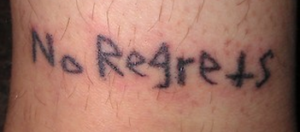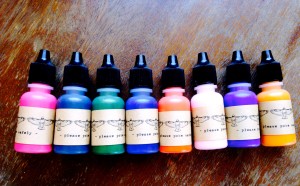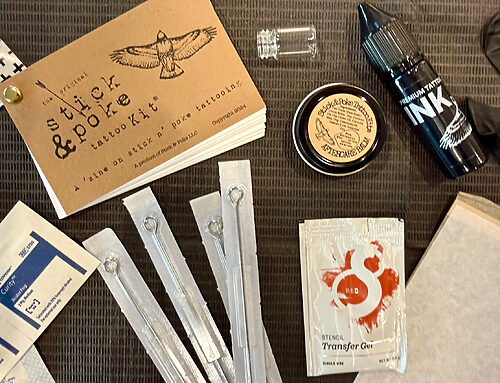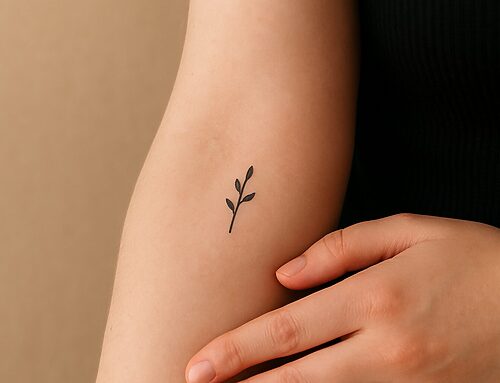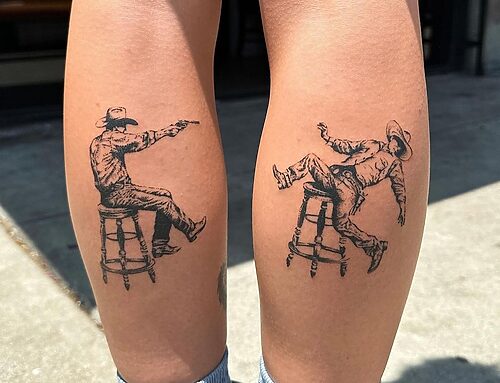I am not a professional tattoo artist (yet), merely a Stick and Poke Safety Advocate (Harm REDUX!). I found some info that might help some of you out there regarding tattooing, inks & skin behavior. I got this information from the Spirit Galley Tattoo (located in Connecticut, USA) Web Page. I think this tattoo artist knows what they are talking about.
{NOTE: I JUST interviewed a local professional stick and poker and got some more helpful hints and tips – see that interview here.}
“How is the tattoo applied, and how do people react to tattoo ink over time?Getting a tattoo is permanent, and has some serious implications that you may want to be aware of. While most of the risks are very minimal or even unlikely – here are some things you should know about the inks used in tattooing and how they are applied to your skin.
How far down does the ink go into my skin?Tattoo artists use their skill to apply ink three layers deep into your skin. You have seven layers of skin tissue. By applying the tattoo ink to the skin cells three layers down, the tattoo can remain permanent without causing scar tissue. This also prevents the tattoo from falling out as the top two layers of your skin are constantly regenerating.
Tattoos that are too high up will fade quickly, and often will seem to practically disappear as your skin heals in the first two weeks. If this happens to you it is not a tragedy. You can always tattoo the area again after it is healed and aim for a slightly lower layer.
Most tattoo artists are happy to touch up a tattoo that has lightened due to being placed too high up in your skin. There are some exceptions to this rule that you can read about in future posts on Wrist Tattoos, Ankle and Foot Tattoos, andHand and Finger Tattoos. Other spots that are difficult to gauge the proper depth include elbows and knees. Tattoos placed there may not be guaranteed by your artist, and you may have to pay each time you rework those tattoos.
Tattoos that are placed too deeply into the skin cause scarring. This is why some tattoos are raised while others feel just like your normal skin. Scarring cannot be reversed, so you are best off with an artist who has a great record of tattooing, and who would rather err on the side of caution by tattooing too lightly than too deeply.
Can I be allergic to some inks but not others?Yes. The most common allergies I have seen are to reds and to blues. I once met a man who healed his tattoo perfectly, but all of the yellow was completely missing after the heal.
Being allergic to a specific color of ink can do with the ingredients used for the pigment, or for the base. If you know you are allergic to certain metals or organic materials make sure your artist knows this! Then they can review the materials in each tattoo ink to make sure that you won’t end up with a swollen and irritated tattoo.
{NOTE: My kits now have new colors! Yaay! These are professional tattoo inks of the highest quality- Bloodline!}
If I have never had a problem with being tattooed, can I develop an allergy to the same tattoo inks later on?Sadly, this is true. Even though you may have several hours of tattoos already healed to perfection on your body, spontaneous allergies can develop. The good news is that once a tattoo is healed, that tattoo will probably not reject any ink even if you suddenly develop a reaction to that same color ink in the new tattoo. I personally don’t know of any cases of a prior tattoo suddenly rejecting color after a new tattoo has a reaction.
Where does all the ink go when my tattoo fades or ages?
Our skin is pretty amazing, and our skin cells hold the tattoo ink in tiny pockets within each cell. Think of it as a casing that holds the tattoo ink in its place within each cell. {Here’s another link on that alone, if you are interested.}
As you get older, your skin cells have to regenerate as old cells die. With each splitting of a cell to create a new one, a small fraction of your tattoo ink moves to another location in the new cell. Over time, this causes the tattoo to “spread.” That’s why tattoos that are 50 years old look really faded and their edges are no longer crisp and tight.
Fading is the result of the tattoo ink either spreading into more or new cells over time, or can be a result of ink loss through chemical reaction. The sun has the ability to break down pigments with long exposure. So a tattoo that has been in the sun a lot will fade faster than a tattoo that is kept covered when outdoors.
If the tattoo inks break down in your body, they cease to be the same substance that they once were. Your body absorbs and eliminates the unwanted or non-useful material through your lymph system. This is what happens when people use laser tattoo removal.
What happens in an allergic reaction to tattoo ink?
In most cases, an allergic reaction to a tattoo pigment will result in an irritated and itchy tattoo that takes a month to heal instead of two weeks to heal. Scabbing will be more common in a tattoo that is experiencing an allergic reaction.
If one color in your tattoo seems to be scabbing up while the rest of the tattoo is healing very well, this can be evidence of an allergic reaction to the tattoo. Once the tattoo is healed, if that color is very faded, you may wish to consult with your artist to come up with an alternative ink for future sessions.
NOTE: I am not a doctor, nor a dermatologist. When in doubt, please seek medical attention and advice. If you are in pain or experiencing symptoms that give you concern, it is always best to seek immediate medical attention.
Is there a special tattoo ink that can cover my scars?
There is no special ink specifically made for tattooing over scars that I am aware of. Most tattoo artists will use the same inks they always use when working over scarred skin. Scars have special needs when it comes to tattooing.
How much ink gets into my skin during a tattoo?
You may have noticed that tattooing can be pretty messy, with lots of smearing of ink. The truth is, very little ink actually gets placed in your skin. The vast majority of the ink pools up on top of your skin and needs to be wiped away.
Tattooing is not an injection.
The needles are poking holes into your skin, and the ink that is stored in the ink-well section of the tattoo tube run down the needles into the hole. As the needle raises back up, a very small amount of pigment is left behind, to be encased and healed into the skin cell.
The top layers of your skin will seem to hold a lot of very bright color. As your tattoo heals, these top two layers of skin will peel off, and the ink that was stuck in those cells will come off with it.
{Want to do this yourself? Check out my tattoo kits here }
Do certain colors of tattoo ink hurt more than others?
Because the process of applying the ink to your skin is the same no matter what color you are putting into it, my answer is no. But if you asked my manager, Lari, he’d tell you that white always hurts the most. That’s because it’s always the last color we put into tattoos for final highlights. So I suppose, the last color you use is always the most painful, because you know you are almost done! “

